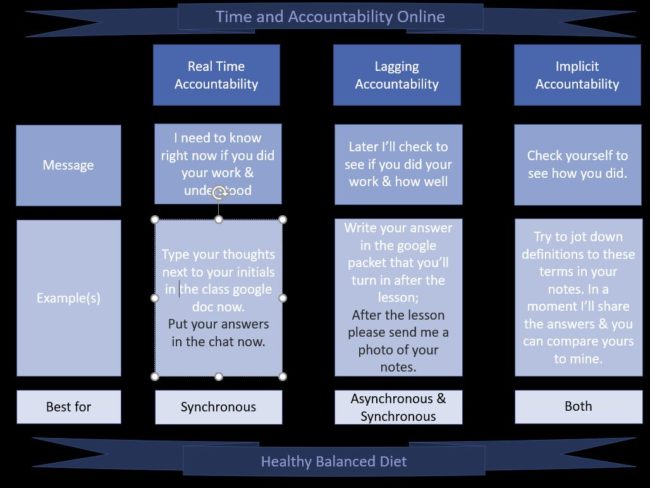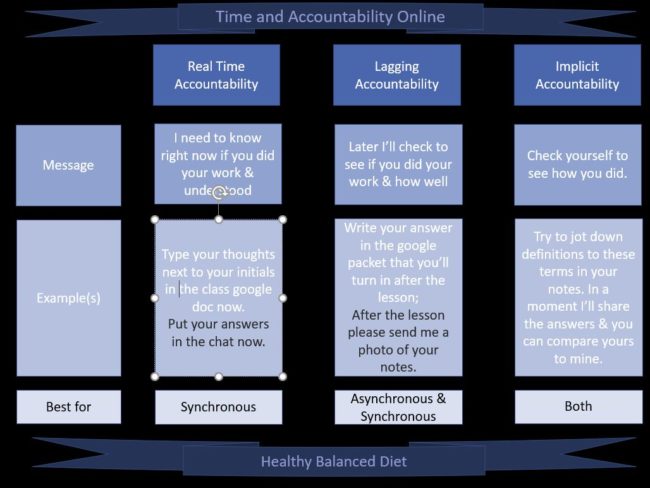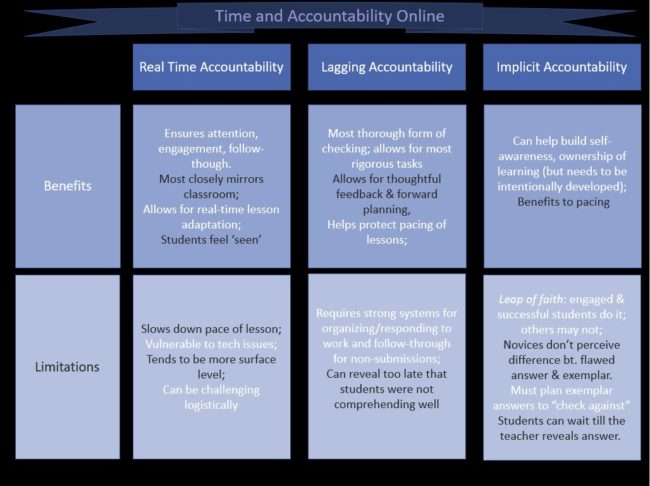03.27.20Accountability and Feedback Online: One Big Questions is ‘When?’

Team TLAC and I had the pleasure of watching several online lessons from schools across the country (and in England) this week and having watched them I want to share a reflection.
One of the constant challenges when you are talking to a screen is knowing what your students are doing as they watch it in some distant room, often at an undetermined time. Are they listening? Thinking deeply? Trying to pay attention but struggling to focus? Playing Fortnight on the other screen? Letting their minds wander? Are they confused? Are they listening? Do they care?
We observed, in observing all week, a variety of responses to this great accountability conundrum. One lesson in particular got me thinking. I both liked it and found that it raised questions for me–often about the things I liked.
One of the questions I found myself thinking about was when accountability (and feedback on student work) happened. There were, essentially, three possible approaches.
Teachers could say something like, “Try to jot down definitions to these terms in your notes. In a moment I’ll share the answers & you can compare yours to mine.” I’d call that Implicit Accountability. Students are on their honor. Hopefully they do the task and compare their answers diligently. If they do they will come to own responsibility for their learning more- a beautiful thing. Certainly some students will. But there may be a disparate impact. Some won’t do the tasks. Others may game the system- just letting the video roll and observing the teacher’s answer. One of my colleagues saw her daughter in this: “She’s been doing a lot of that- she’s not trying to game the system, it’s just really hard to concentrate when you are getting less teacher attention and feedback than usual and the work is confusing.”
Another option would be to say something like “Write your answer in the google packet” throughout the lesson and then have them turn it in after. Call that Lagging Accountability because it happens after an undetermined delay in time. This is a good strategy because it lets you assign tasks of substance and merit but the time lag can be problematic. Students could tune out or labor under misconceptions all lesson long and you’d never know it.
A final option would be to say something like, “Type your answers into the chat now.” Call that Real Time Accountability. Using it would mean you’d know right away who was tuned in and you could make real time decisions on what students understood. And you’d cause students to pay more attention. But then again attending to a stream of answers in the chat or some other for of live feedback while you’re teaching is super challenging. It requires the technology to work and your brain to multitask when, arguably, it’s already multi-tasking.
So which of these three types of accountability is best?
None of them. Students will probably benefit most from a healthy balanced diet of all three. And consciousness is curative. Being aware of the three ways to enact accountability helps you manage them intentionally and discuss or share what you learn with peers –and us we hope. Perhaps you ask them to write their definitions to five vocab words in their notebooks. You come back on and share the answers to three of them and ask them to self-check. Then you say: “Great now email me your definitions for the other two.”
In light of that here are some slides laying out the three time frames in which to try to enact accountability with some examples. After that I’ll try to share some links where you can see them in action.


What about video examples?
You can see Real Time Accountability in Alex Barba’s Cold Calling during her lesson.
You can see Lagging Accountability in George Bramley’s student packet.
Sara Sherr’s lesson shows both Implicit Accountability (“write down your vocab definitions in your notebook”) and a hint of lagging accountability (“and try to use them in the answers you’ll submit later.”)
Also check out this video of Seth Kumar-Hull at Creo Prep in the Bronx using Implicit Accountability, asking students to write a summary of a passage he’s read them and then encouraging them self-check it against his summary.
Seth’s lesson is full of language encouraging students to own their learning. “You answer and then I’ll show you the right answers to help you hold yourself accountable …” Or before vocabulary practice, “This is what we call active practice. You are taking your definitions and applying them in new situations.” And after: “now you’ve helped commit those meanings to memory…”
In other words if you want Implicit Accountability to work for students it’s going to be important to build a culture of how and why around it.
